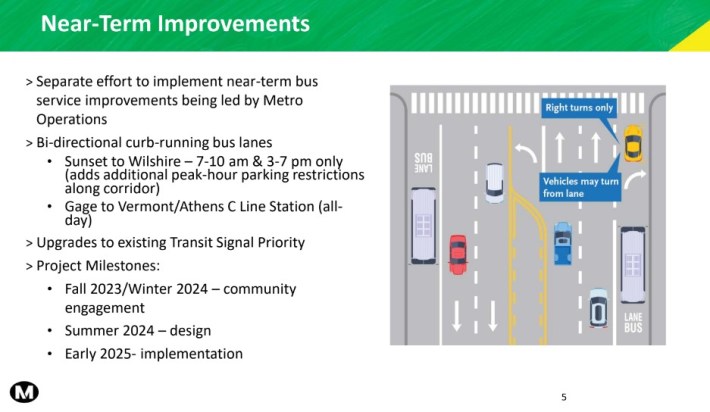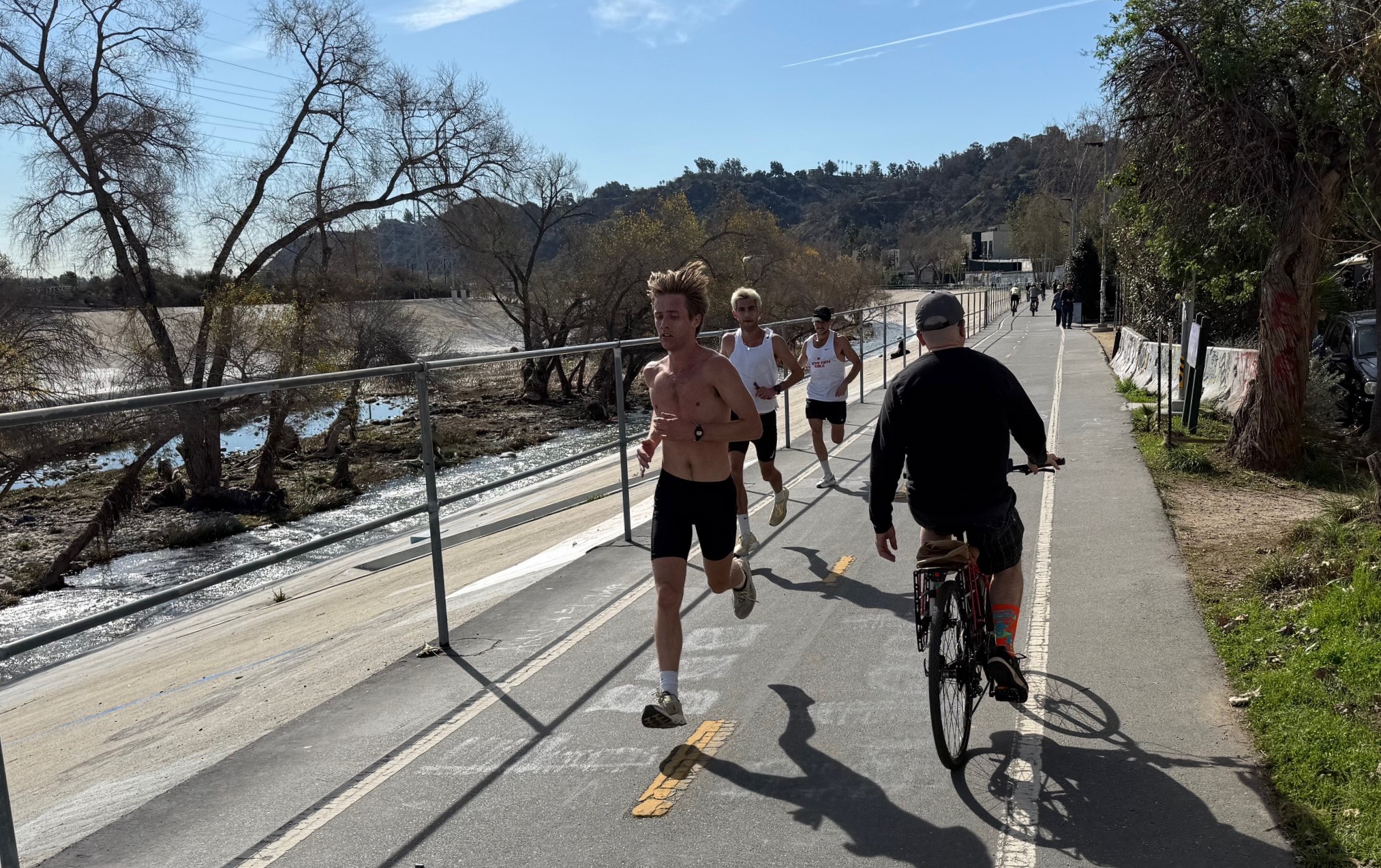This week saw the beginning of what could be the first legal challenge under the city's half-year-old Measure HLA requirements. Metro is looking to make significant changes to Vermont Avenue, mainly new bus lanes. Advocates say Metro needs to think bigger; Streets for All says the latest plan falls short of complying with HLA.
Vermont Avenue has long been among Metro's (and the nation's) highest ridership bus streets. For at least a decade, Metro has been glacially slowly planning Vermont Avenue bus improvements. The project gained momentum with 2016 Measure M funding, but Metro studies in 2018 and in 2019 didn't quite get the fiscally-cheap and politically-expensive project ready for its c. 2024 scheduled groundbreaking.
For the 12 mile project, Metro announced an initial phase including about six miles of bus-only lanes. A second phase Metro is "studying" would extend the bus lanes (potentially for the entire length) and include 26 (13 northbound, 13 southbound) major bus stop upgrades, essentially converting stops to BRT (Bus Rapid Transit) stations. Unspecified, unfunded future phases remain a possibility.
Advocates see Vermont as a key opportunity. If you can't go big, be thorough, and make transit and transit riders a top priority on one of Metro's and the nation's highest ridership corridors, where can you?
The Alliance for Community Transit (ACT-LA) is currently circulating a letter (sign on as an individual or organization) in support of improving Vermont for people on bus, bike, and on foot - from Sunset Boulevard to the Metro C (Green) Line Athens Station. ACT-LA and two dozen organizations are calling for following features all along the nearly 12-mile-long project:
- uninterrupted bus lanes
- protected bike lanes
- pedestrian scrambles at high injury and bus transfer intersections
- tree planting, non-hostile shelters, signage, wayfinding, trash bins, and a bus rider bill of rights at every stop
- wait time displays and public water at all major intersections
- electrification of buses along the corridor
- preserving all street vending and expanding the sidewalk in areas with high vending concentrations
For the near term, Metro is looking to spend its Vermont Measure M funds on a much less expansive project.

According to a recent Vermont Transit Corridor presentation, Metro is looking to add about six miles of bus lanes (2.5 miles from Sunset to Wilshire Boulevard and 3.7 miles from Gage Avenue to the C Line) in 2025. Metro would later (c. 2028) extend the bus lanes, and add "light rail-like stations with enhanced shelters and more passenger amenities for comfort and safety," featuring off-bus fare payment, all-door boarding, and "bus bulbs at stations [that] would extend the pedestrian area and shorten crossings with less exposure to vehicle traffic."
Metro is including little for pedestrians, and nothing for cyclists.
In the same presentation, Metro asserts that the project is consistent with the city's Mobility Plan and that it "helps support" the city's Measure HLA.
Streets for All disagrees.

The city Mobility Plan 2035 [map] designates all 12 miles of the Vermont Transit Corridor project for bus, walk and bike upgrades. The entire length is designated to receive bus lanes and pedestrian enhancements. South of 60th Place (near Gage Avenue), the plan approved protected bike lanes, and from 60th Place north, unprotected bike lanes.
Measure HLA now requires that planned bus/bike/walk features are installed during nearly any city road work at least one-eighth of a mile long. Generally street resurfacing is what triggers HLA, but the law is a little broader than just resurfacing. HLA requirements are triggered by "any paving project or other modification" excluding really small stuff: "restriping of the road without making
other improvements, routine pothole repair, utility cuts, or emergency repairs.”
For about six miles of Vermont, Metro is planning new bus lanes, new BRT stations, while omitting planned bike upgrades.
This week, the advocacy group Streets for All, the main proponent of Measure HLA and one of the signatories of the ACT-LA letter, wrote to Mayor Karen Bass and Metro CEO Stephanie Wiggins in support of Metro's Vermont project proceeding in full compliance with Measure HLA. The letter states:
As designed, the BRT project brings (welcome) improvements to Vermont Avenue... Those trigger the City’s obligation to install Mobility Plan enhancements. Therefore, were the City to issue permits for the project without assuring implementation of its Mobility Plan enhancements at the same time, the City would violate its ordinance, waste public funds, and allow Vermont’s dangerous conditions to remain despite the voters’ mandate.
Streets for All notes that the project complies with the city's plan for transit and pedestrian facilities, but not for bikeways.
It is not entirely clear what is behind Metro's omission of planned Vermont Avenue bike lanes. The fiscal cost of adding bike lanes (contrary to pre-HLA fearmongering) is minimal, especially during any kind of restriping. There are political costs, though, in re-allocating car space to bikeways. Especially north of Gage, adding the approved bike lanes will mean reducing on-street parking (or narrowing/eliminating car travel lanes), which the city and Metro have been reluctant to do, even in population-rich, transit-rich locations like Vermont Avenue.
SFA's letter notes that there are other projects that Metro is doing in L.A. City that don't comply with Measure HLA. Sadly, Metro has a history of omitting planned bike facilities - from downtown L.A. subway stations to Rosa Parks Station to many other projects. Streetsblog has compiled a list of several future Metro projects that do not appear to be in compliance with the city's Mobility Plan (it's unlikely that this list is comprehensive):
105 Freeway Express Lanes
Metro and Caltrans planned 105 Freeway Express Lanes project includes widening several surface streets leading to the freeway: Central Avenue, Fir Street, Bullis Road, Harris Avenue, and Imperial Highway. Some of these are outside the city, but Metro plans to widen L.A.'s 90-feet-wide Central Avenue by 11 feet to add more car capacity. The Mobility Plan calls for narrowing Central to 70 feet and adding protected bike lanes, which are not in Metro's plans.
East San Fernando Valley Transit Corridor
MP2035 designates Van Nuys Boulevard for protected bike lanes for the entire 6+mile length of phase 1 of East San Fernando Valley light rail. Two miles of Van Nuys have existing unprotected bike lanes that appear to be slated for removal in Metro rail plans.
Florence Ave bus lanes
Metro plans to add about five miles of new bus lanes on Florence Avenue mostly in L.A. City (plus a short stretch in unincorporated L.A. County). The project was initially expected to be completed in 2023, but has been delayed multiple times. The project website now forecasts a Winter 2025 opening. Under Measure HLA, the L.A. City part of the project is now required to also add new bike lanes and pedestrian enhancements.
K Line Northern Extension
Planning is underway to extend the K Line north. Depending on the final alignment, the project will trigger numerous MP2035 upgrades, likely including:
- Crenshaw Boulevard: bus lanes, bike lanes, and walk enhancements
- Adams Boulevard: bike lanes and walk enhancements
- Venice Boulevard: bus lanes, bike lane upgrades and walk enhancements
- San Vicente Boulevard: bike lane upgrades and walk enhancements
- Fairfax Avenue: bus lanes, bike lanes, and walk enhancements
- La Brea Boulevard: bike lanes and walk enhancements
Wilshire D Line Subway
Prior to HLA, Metro asserted that D Line subway construction is not subject to the city's Mobility Plan, as the full three sections of the project were environmentally cleared prior to 2015 MP2035 approval. Measure HLA makes no exceptions based on project approval dates, but applies to when street work (resurfacing, striping) takes place. Section 1 D Line subway construction street reconstruction (currently nearing completion) was perhaps too far along for HLA to trigger upgrades on Wilshire Boulevard, La Brea, and Fairfax. Section 2 construction could trigger Constellation Boulevard and Avenue of the Stars upgrades. Section 3 may trigger upgrades to Wilshire, Gayley Avenue, and Westwood Boulevard.
LinkUS Union Station Run-Through Tracks
Metro's LinkUS project includes changes to North Main Street that appear to ignore Mobility Plan designations for bus lanes, protected bike lanes, and pedestrian enhancements.
Post updated October 9 to clarify and correct descriptions of Vermont Transit Corridor project phases.







